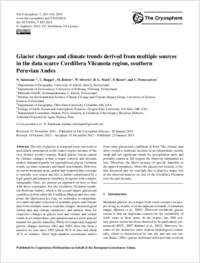Glacier changes and climate trends derived from multiple sources in the data scarce Cordillera Vilcanota region, southern Peruvian Andes
- Salzmann, Nadine Department of Geography, University of Zurich, Switzerland - Department of Geosciences, University of Fribourg, Switzerland
- Huggel, C. Department of Geography, University of Zurich, Switzerland
- Rohrer, M. Meteodat GmbH, Zurich, Switzerland
- Silverio, W. Institute for Environmental Science, Climate Ch ange and Climate Impact Group, University of Geneva, Switzerland
- Mark, B. G. Department of Geography, Ohio State University, Columbus USA
- Burns, P. College of Earth, Ocean and Atmospheric Sciences, Oregon State University, Corvallis, USA
- Portocarrero, C. Independent Consultant, Huaraz, Peru, formerly at Unidad de Glaciología y Recursos Hídricos, Autoridad Nacional de Agua, Huaraz, Peru
-
23.01.2013
Published in:
- The Cryosphere. - 2013, vol. 7, p. 103-118
English
The role of glaciers as temporal water reservoirs is particularly pronounced in the (outer) tropics because of the very distinct wet/dry seasons. Rapid glacier retreat caused by climatic changes is thus a major concern, and decision makers demand urgently for regional/local glacier evolution trends, ice mass estimates and runoff assessments. However, in remote mountain areas, spatial and temporal data coverage is typically very scarce and this is further complicated by a high spatial and temporal variability in regions with complex topography. Here, we present an approach on how to deal with these constraints. For the Cordillera Vilcanota (southern Peruvian Andes), which is the second largest glacierized cordillera in Peru (after the Cordillera Blanca) and also comprises the Quelccaya Ice Cap, we assimilate a comprehensive multi-decadal collection of available glacier and climate data from multiple sources (satellite images, meteorological station data and climate reanalysis), and analyze them for respective changes in glacier area and volume and related trends in air temperature, precipitation and in a more general manner for specific humidity. While we found only marginal glacier changes between 1962 and 1985, there has been a massive ice loss since 1985 (about 30% of area and about 45% of volume). These high numbers corroborate studies from other glacierized cordilleras in Peru. The climate data show overall a moderate increase in air temperature, mostly weak and not significant trends for precipitation sums and probably cannot in full explain the observed substantial ice loss. Therefore, the likely increase of specific humidity in the upper troposphere, where the glaciers are located, is further discussed and we conclude that it played a major role in the observed massive ice loss of the Cordillera Vilcanota over the past decades.
- Faculty
- Faculté des sciences et de médecine
- Department
- Département de Géosciences
- Language
-
- English
- Classification
- Hydrology
- License
- License undefined
- Identifiers
-
- RERO DOC 31874
- DOI 10.5194/tc-7-103-2013
- Persistent URL
- https://folia.unifr.ch/unifr/documents/303115
Statistics
Document views: 75
File downloads:
- sal_gcc.pdf: 201
